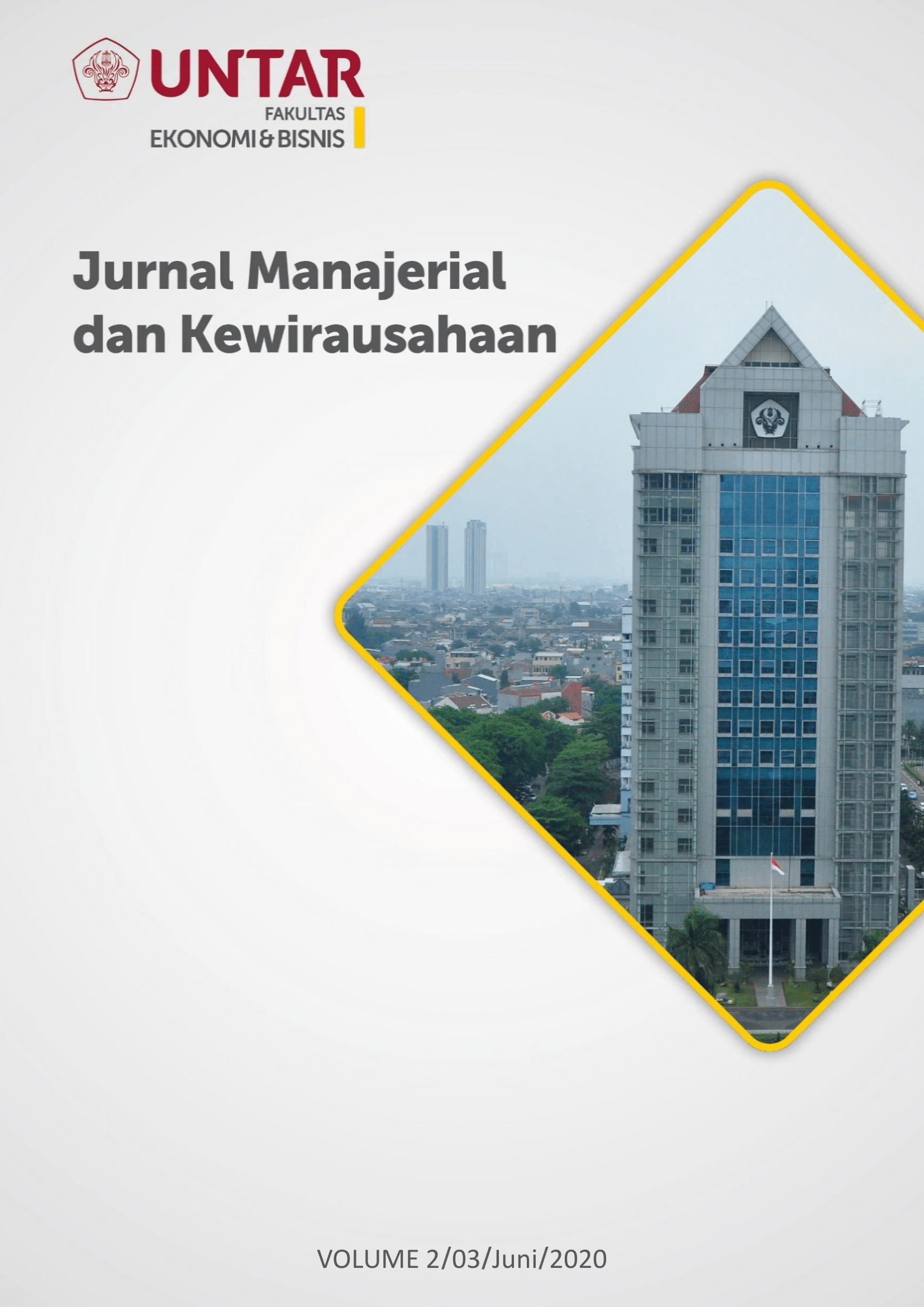Pengaruh Perceived Ease Of Use, Perceived Usefulness, dan Trust terhadap Intention To Use
Main Article Content
Abstract
The purpose of this study is to examine whether perceived ease of use, perceived usefulness, and trust are positive predictors of Intention to use DANA in Jakarta. The population of this research is the DANA users who live in Jakarta, from the entire population of researchers who used only 200 people as samples selected using convinience sampling methods, by distributing questionnaires online, the data were then processed using smartPLS-SEM. The result of this research is perceived ease of use and perceived usefulness affect intention to use, and the trust can’t affect the intention to use.
Tujuan dari penelitian ini adalah untuk menguji apakah persepsi kemudahan penggunaan, persepsi manfaat, dan kepercayaan merupakan prediktor positif dari niat untuk menggunakan DANA di Jakarta. Populasi penelitian ini adalah pengguna DANA yang tinggal di Jakarta, dari seluruh populasi peneliti yang menggunakan hanya 200 orang sebagai sampel yang dipilih menggunakan metode convenience sampling, dengan mendistribusikan kuesioner secara online, data kemudian diproses menggunakan smartPLS-SEM. Hasil dari penelitian ini adalah persepsi kemudahan penggunaan dan persepsi kegunaan mempengaruhi niat untuk menggunakan, dan kepercayaan tidak dapat mempengaruhi niat untuk menggunakan.
Article Details
This work is licensed under a Jurnal Muara Ilmu Ekonomi dan Bisnis Creative Commons Attribution-ShareAlike 4.0 International License.,/p>
References
Ajzen, Icek., (2005). Attitudes, Personality, and Behavior. 2nd Edition. New York : Open.
Alalwan, A. A., Dwivedi, Y. K., Rana, N. P., & Simintiras, A. C. (2016). Jordanian consumers’ adoption of telebanking: Influence of perceived usefulness, trust and self efficacy. International Journal of Bank Marketing, 34(5), 690-709.
Chawla, D., & Joshi, H. (2019). Consumer attitude and intention to adopt mobile wallet in India–An empirical study. International Journal of Bank Marketing, 37(7), 1590- 1618.
Chemingui, H., & Ben lallouna, H. (2013). Resistance, motivations, trust and intention to use mobile financial services. International Journal of Bank Marketing, 31(7), 574-592.
Cudjoe, A. G., Anim, P. A., & Nyanyofio, J. G. N. T. (2015). Determinants of mobile banking adoption in the Ghanaian banking industry: a case of access bank Ghana limited. Journal of Computer and Communications, 3(02), 1.
Davis, F. D. (1989). Perceived usefulness, perceived ease of use, and user acceptance of information technology. MIS quarterly, 319-340.
Ghazali, E. M., Mutum, D. S., Chong, J. H., & Nguyen, B. (2018). Do consumers want mobile commerce? A closer look at M-shopping and technology adoption in Malaysia. Asia Pacific Journal of Marketing and Logistics, 30(4), 1064-1086.
Hair, J. F., Ringle, C. M., & Sarstedt, M. (2011). PLS-SEM: Indeed a silver bullet. Journal of Marketing theory and Practice, 19(2), 139-152.
Henseler, J., Ringle, C. M., & Sarstedt, M. (2015). A new criterion for assessing discriminan validity in variance-based structural equation modeling. Journal of the academy of marketing science, 43(1), 115-135.
Hur, Y., Ko, Y. J., & Claussen, C. L. (2012). Determinants of using sports web portals: An empirical examination of the sport website acceptance model. International Journal of Sports Marketing and Sponsorship, 13(3), 6-25.
Indarsin, T., & Ali, H. (2017). Attitude toward Using m-Commerce: The Analysis of Perceived Usefulness Perceived Ease of Use, and Perceived Trust: Case Study in Ikens Wholesale Trade, Jakarta–Indonesia. Saudi Journal of Business and Management Studies, 2, 995-1007.
Jamshidi, D., & Hussin, N. (2016). Forecasting patronage factors of Islamic credit card as a new e-commerce banking service: an integration of TAM with perceived religiosity and trust. Journal of Islamic Marketing, 7(4), 378-404.
Kumar, A., Adlakaha, A., & Mukherjee, K. (2018). The effect of perceived security and grievance redressal on continuance intention to use M-wallets in a developing country. International Journal of Bank Marketing, 36(7), 1170-1189.
Leon, S. (2018). Service mobile apps: a millennial generation perspective. Industrial Management & Data Systems, 118(9), 1837-1860.
Lu, Y., Yang, S., Chau, P. Y., & Cao, Y. (2011). Dynamics between the trust transfer process and intention to use mobile payment services: A cross-environment perspective. Information & Management, 48(8), 393-403.
Teo, T., Faruk Ursava?, Ö., & Bahçekapili, E. (2011). Efficiency of the technology acceptance model to explain pre-service teachers' intention to use technology: A Turkish study. Campus-Wide Information Systems, 28(2), 93-101.
Tojib, D., & Tsarenko, Y. (2012). Post-adoption modeling of advanced mobile service use. Journal of Business Research, 65(7), 922-928.
Yadav, R., & Pathak, G. S. (2017). Determinants of consumers' green purchase behavior in a developing nation: Applying and extending the theory of planned behavior. Ecological Economics, 134, 114-122.
Zhang, T., Lu, C., & Kizildag, M. (2018). Banking “on-the-go”: examining consumers’ adoption of mobile banking services. International Journal of Quality and Service Sciences, 10(3), 279-295.
Zhou, T. (2013). An empirical examination of continuance intention of mobile payment services. Decision support systems, 54(2), 1085-1091



